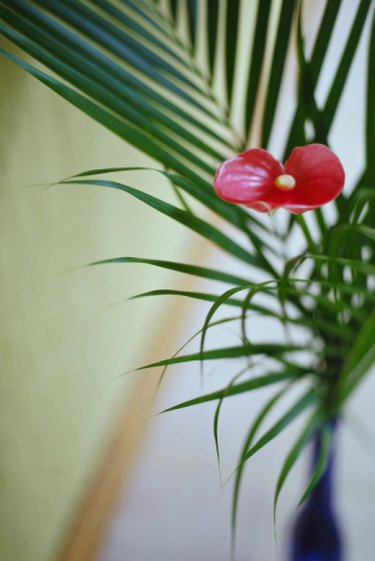
Fruit fly infestations are a harmless, yet annoying problem. Also called pomace or vinegar flies, these tiny insects are drawn to rotting material and moist areas. In spite of their name, they are not found only around fruit. Indoor plants, kitchen sink drains and bathtubs are common sources for fruit fly infestations. If you have an indoor palm plant, you may experience swarms of fruit flies around it.
Identification
Video of the Day
Fruit flies are 1/8-inch long flying insects with red eyes and brown-black bodies. A single adult fruit fly lays up to 500 eggs on a rotting or moist surface. Once the eggs hatch into larvae, they feed on rotting material and grow into an adult within a week. Fruit flies are often confused with fungus gnats. Whereas fruit flies have thick bodies, gnats have slender bodies and long legs similar to mosquitoes. Gnats are about the same length as fruit flies but have gray-black bodies. They also breed at rapid rates.
Video of the Day
Prevention
Avoiding fruit fly infestations in the first place is the most effective form of pest control. Avoid overwatering your palm plant because excess moisture around plants attracts fruit flies. Frequently empty the drip container under your palm plant. When watering the palm plant, be sure the water soaks into the soil instead of sitting on the leaves. Further protect your indoor palm plant by discouraging fruit flies from entering your home. Remove or clean all sources that attract fruit flies. These include emptying garbage containers daily, drying sinks and bathtubs after use and storing fresh fruits and vegetables in the refrigerator.
Solution
If your palm plant already has a fruit fly infestation, you can use several nonchemical methods to decrease their numbers. Use flying insect traps to reduce the number of adult insects. Sticky insect tapes are readily available. If you prefer, you can make your own by applying double-sided tape to a strip of cardboard. Or, you can pour few tablespoons of apple cider vinegar and a few drops of dish detergent into a shallow dish. Be sure to place the trap as close as possible to the palm plant. If fly eggs and larvae are living in the plant, use a pesticide that is safe for your specific type of palm.
Warning
Always follow the instructions on your pesticide to apply it correctly. Be sure to use pesticides in a well-ventilated area. Insect traps will kill many adult fruit flies, but they will not cure an infestation problem if eggs and larvae exist on the palm plant. If the palm plant is severely infested with fruit flies, it may need to be discarded. Moving the plant outdoors or throwing it away will prevent the fruit flies from spreading to other palm plants in your home.
- University of Kentucky College of Agriculture; Fruit Flies; Michael F. Potter; January 2010
- U. S. General Services Administration IPM Program; Fruit Flies and Fungas Gnats; November 2006
- University of Minnesota Extension; Houseplant Insect Control; Jeffrey Hahn, et al.
- ISU Entomology; Fruit Flies, Vinegar Flies, Pomace Flies; December 2005